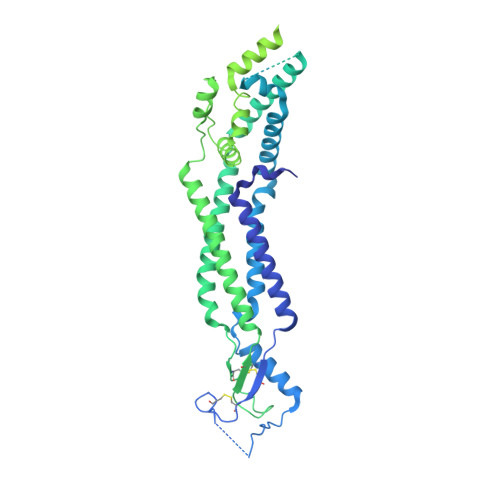Small molecule SWELL1 complex induction improves glycemic control and nonalcoholic fatty liver disease in murine Type 2 diabetes.
Gunasekar, S.K., Xie, L., Kumar, A., Hong, J., Chheda, P.R., Kang, C., Kern, D.M., My-Ta, C., Maurer, J., Heebink, J., Gerber, E.E., Grzesik, W.J., Elliot-Hudson, M., Zhang, Y., Key, P., Kulkarni, C.A., Beals, J.W., Smith, G.I., Samuel, I., Smith, J.K., Nau, P., Imai, Y., Sheldon, R.D., Taylor, E.B., Lerner, D.J., Norris, A.W., Klein, S., Brohawn, S.G., Kerns, R., Sah, R.(2022) Nat Commun 13: 784-784
- PubMed: 35145074
- DOI: https://doi.org/10.1038/s41467-022-28435-0
- Primary Citation of Related Structures:
7M17, 7M19 - PubMed Abstract:
Type 2 diabetes is associated with insulin resistance, impaired pancreatic β-cell insulin secretion, and nonalcoholic fatty liver disease. Tissue-specific SWELL1 ablation impairs insulin signaling in adipose, skeletal muscle, and endothelium, and impairs β-cell insulin secretion and glycemic control. Here, we show that I Cl,SWELL and SWELL1 protein are reduced in adipose and β-cells in murine and human diabetes. Combining cryo-electron microscopy, molecular docking, medicinal chemistry, and functional studies, we define a structure activity relationship to rationally-design active derivatives of a SWELL1 channel inhibitor (DCPIB/SN-401), that bind the SWELL1 hexameric complex, restore SWELL1 protein, plasma membrane trafficking, signaling, glycemic control and islet insulin secretion via SWELL1-dependent mechanisms. In vivo, SN-401 restores glycemic control, reduces hepatic steatosis/injury, improves insulin-sensitivity and insulin secretion in murine diabetes. These findings demonstrate that SWELL1 channel modulators improve SWELL1-dependent systemic metabolism in Type 2 diabetes, representing a first-in-class therapeutic approach for diabetes and nonalcoholic fatty liver disease.
- Department of Internal Medicine, Cardiovascular Division, Washington University School of Medicine, St. Louis, MO, USA.
Organizational Affiliation:


















